Responsive Website Design: What It Is And How To Use It
Responsive website design is an approach that guarantees web pages will look great and work optimally on all devices or screen sizes. With the ascent of mobile gadgets and differing screen resolutions, websites must acclimate to various conditions. The responsive design accomplishes this by utilising HTML and CSS to powerfully change the layout and content of web pages to fit different screens.
In today's advanced world, a consistently expanding number of individuals are getting to the internet using various gadgets, from desktop computers to smartphones and tablets. This assorted variety in devices and screen sizes presents a test for website designers and developers.
A webpage that looks extraordinary on a desktop computer may be complex to explore on a small smartphone screen – which is where responsive website design comes in.
Responsive design empowers sites to modify their layout and content to give the ideal client experience, paying little heed to the utilised devices. Whether it's an enormous desktop monitor or a minuscule smartphone screen, responsive websites adjust perfectly according to the device/screen size, giving an ideal surveying/navigational experience.
However, responsive design isn't just about ensuring a site looks great on various gadgets; it additionally guarantees that the site works impeccably over every stage—so buttons are anything but complex (and pleasant) mouse/tap targets, forms are anything but complex (and lovely) TO fill out effectively: everything loads rapidly even when dealing with pictures/graphics. By considering user needs across devices/screen sizes, etc., we deliver accessibility and usability first!
Table of Contents
Importance of Responsive Design
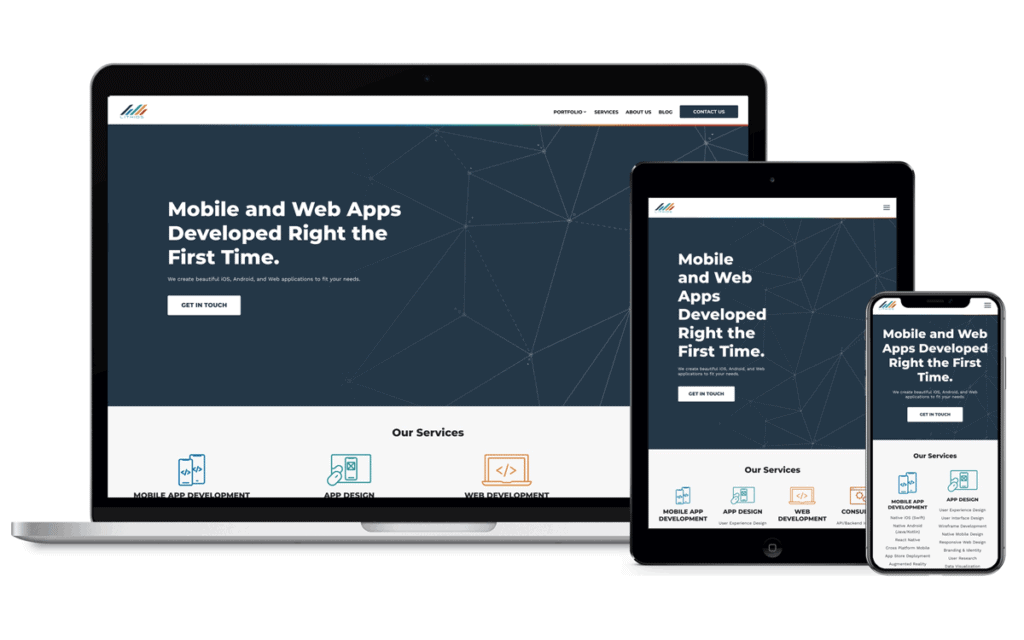
Responsive design is vital because it guarantees consistent visual experiences for websites across screens (desktop, tablet, mobile phone). This consistency helps to maintain a brand image and good user experience. For example, if a website looks great on a desktop but appears distorted and difficult to navigate on a smartphone, this inconsistency can create frustration and a negative brand perception. However, with responsive design, which adapts to different screen sizes automatically, you'd have the same look and feel from device to device.
The second reason why responsive design is essential is that it improves user experience, so you're more likely to gain engagement and lower bounce rates. Suppose users can easily browse your site or access its content no matter their device. That's much better than abandoning your site in frustration because they found navigating it too tricky on their mobile or tablet computer. The former scenario could mean longer session durations, higher page views, and more conversions.
Another advantage of responsive design is that it simplifies analytics reporting: should you roll out one responsive website rather than separate sites for desktop PCs/laptops/phones/tablets? With just one site, tracking user behaviour becomes more accessible and accurate as there isn't data fragmentation from multiple sites – mobile plus desktop.
In addition, search engines like websites are mobile-friendly! So, by going down this route, businesses stand an improved chance of attracting organic traffic/search engine visibility. By ‘responsive', I mean fluidly changing layout depending on whether people view your site via laptop/desktop or smaller-screened devices such as tablets/mobiles/etc.
For prioritising purposes in their rankings' algorithms, search engines consider how friendly mobile websites are when deciding where to list them in search results.
So companies can maximise chances of greater online visibility and organic traffic by opting for one SEO-friendly web address instead of two (one each for desktop/laptop computers versus another for smartphones/tablet computers).
Critical Principles of Responsive Design
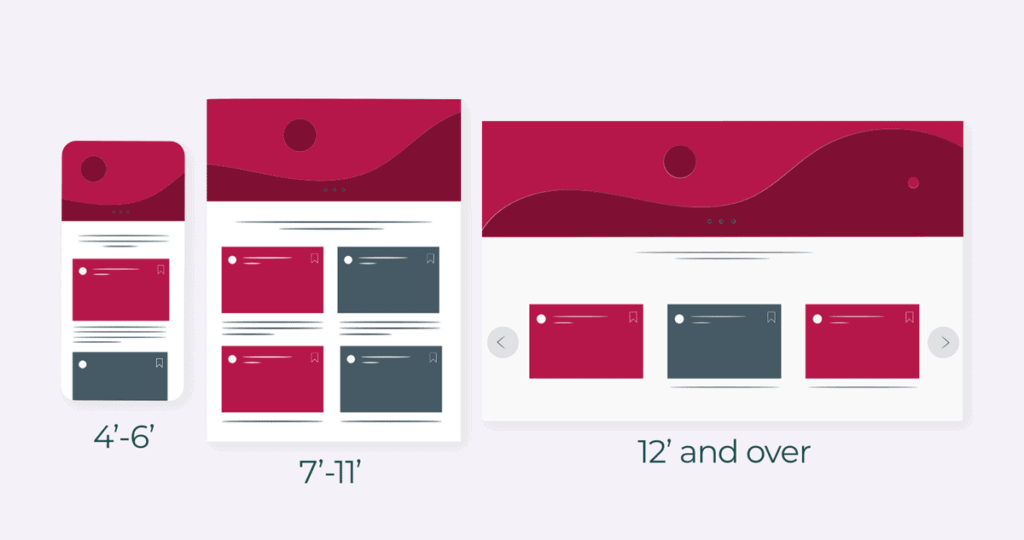
Responsive design relies on several fundamental principles. One of these is flexible layouts and grids, which allow content to adapt to different screen sizes. Using percentage-based measurements and fluid grids, web pages can automatically adjust elements to fit the available space.
Consider a website with a three-column layout on a desktop screen. On smaller screens, such as smartphones, the columns may need to be narrower for practical use. With responsive design, however, these columns would be rearranged into a single-column layout, making it easier to read and navigate using a smaller screen.
Another essential principle is flexible images; responsive design ensures that images scale proportionally and resize appropriately according to the device used so they are neither too large nor small on different screens.
Imagine a website with an impressive banner image at the top of its homepage. This might be displayed at full size on a desktop computer for maximum impact. But on smartphone-sized devices (to name but one), this image might take up far too much room, pushing other content below ‘the fold'. With responsive design applied correctly, these images will resize or shrink in line with device size – ensuring overall page balance is maintained throughout rendering pleasures equally across all viewing scenarios.
Media queries are another crucial aspect of responsive design because they enable targeted styling based on specific screen dimensions – allowing different stylesheets to be applied depending upon what kind of device someone's using, thereby optimising page appearance further.
Consider how media queries can specify that if the width of the viewport being used by someone browsing falls below 600 pixels – then instead of presenting itself as horizontal menu options, each should collapse down into a hamburger-style dropdown, i.e., becoming more easily accessible and user-friendly when viewports get smaller and smaller.
The last element we will touch upon is essential principles relating to responsive typography, ensuring optimal readability irrespective of the screen size used. Font sizes/line spacings/line lengths will be adjusted to make text legible and visually pleasing on any device.
For example, the text could be shown in larger font sizes to ensure readability on a large desktop screen. However, when viewed on smaller screens, this text may become too small for someone to read comfortably. With responsive design applied correctly, though, these font sizes will automatically scale up so that users can more easily read them without having to zoom in constantly.
Best Practices for Responsive Website Development

To create effective, responsive websites, you should follow several best practices. To ensure a design that puts users at the centre, it is advisable to adopt the mobile-first approach. This means beginning with small screens and then expanding to larger ones. By prioritising essential content and functionality in this way, you can provide a better experience for your users.
For example, imagine that you're designing an e-commerce website that must be responsive. With the mobile-first approach, identify which features and content matter most on small screens – such as easy navigation and product search – and then expand those elements for larger screens by adding more product images or detailed descriptions.
It's essential to understand popular screen resolutions and web browser market share, too: aim your design at what most people use.
For example, if your data tells you that most of your target audience uses a particular web browser on their smartphones with a specific screen resolution, ensure your design provides the best possible experience for these people – even if it involves testing websites on various devices and browsers to make sure everything works as expected.
Another good practice is focusing on user experience (UX) when working with smaller screens: simplify navigation, minimise interactions, and ensure nothing is hard to access unless someone scrolls excessively.
For instance, viewing complex navigation menus requiring many taps/swipes before getting anywhere would be annoying on a tiny smartphone screen. Simplify the menu choices so fewer taps are needed, and people can find what they want without getting lost.
Remember regular testing, too: use tools such as Chrome's Inspect tool or Google's Mobile-Friendly Test to check how different devices/screen sizes render your site; also, keep an eye out for new tech/devices requiring updates/tweaks.
Example: once you've got a responsive website live, test it regularly against multiple device/screen size combinations so it continues providing excellent UX…and keep an eye out for new web design tech/trends in case things can be made even better.
How Responsive Web Design Works
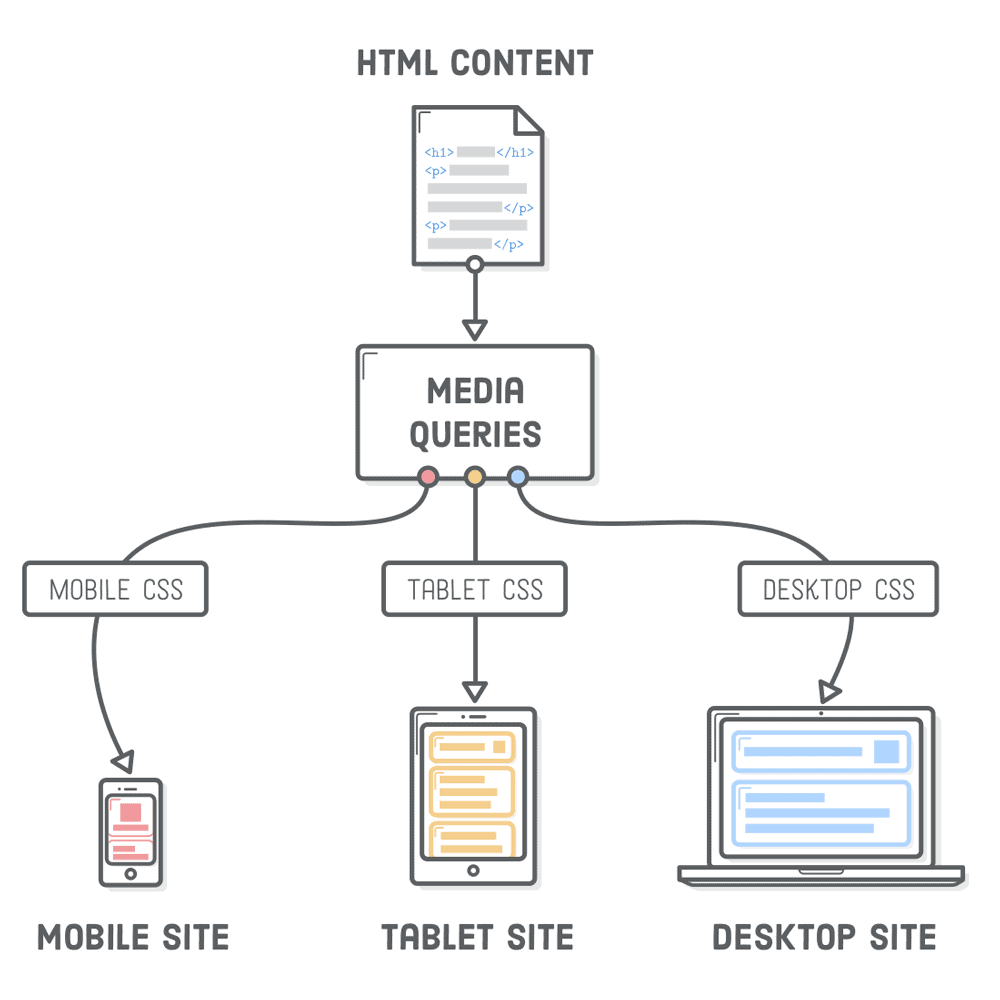
Responsive web design is all about using HTML and CSS to adapt content to different devices, like phones, tablets, and desktop computers. With responsive design techniques, the page layout adjusts itself based on the screen size it's being viewed on. This can mean hiding or shrinking some elements and moving others around.
Fluid grids are a big part of this – rather than fixing each element as a specific number of pixels, you use percentages (or something similar) so that everything scales proportionally. If your website has a 3-column layout on desktop screens that works out at 300px per column, then with fluid grids, each column might be 30% wide when viewed in landscape mode on an iPhone.
The same goes for images – instead of setting an image's width attribute to exactly 200 pixels, you'd put it to something more flexible like “100%” or “50%”. That way, it'll take up half the screen width no matter what device your visitor uses.
Media queries also play a central role in responsive design – they help apply specific styles depending on various factors such as screen size or device capabilities. Together, these techniques create a responsive website design that delivers a great user experience, whatever device people use.
When someone visits your website, their web browser retrieves its HTML structure file(s) and any accompanying CSS style sheet(s). The HTML file(s) contains information about what's going where regarding headings (h1,h2, etc.), paragraphs, lists, etc., while the CSS determines how those things look, e.g. colour, font size, line spacing, etc.
One of the primary tools for responsive web design is CSS media queries. These allow designers to tailor their pages based on the characteristics of a user's device, including screen size and resolution.
For example, a website may specify that if a visitor's screen width is less than 500 pixels, its navigation menu should be displayed as an icon bar instead of multiple rows. This ensures that even users with tiny screens can easily navigate it.
Fluid grids are another central tool in responsive web design. Rather than using fixed pixel values to lay out elements such as text and images, they use percentages so browsers can automatically adjust them according to the available space.
If there were three equal-width columns on a page – perhaps each containing an image and some accompanying text – fluid grids would ensure each filled one-third of the browser window's width. The other two columns would adapt accordingly as you adjust your browser window's size or switch from desktop-based browsing to tablet or mobile viewing (or vice versa).
Similarly significant are responsive images: those which resize themselves depending on how much room they have to do so – but without losing clarity.
Examples of Responsive Web Design

Examples of effective, responsive web design are abundant. Websites like Designmodo, Simon Collison, and Andersson-Wise Architects show how content can adapt and reflow across different devices. This showcases the flexibility of responsive design in providing a smooth user experience.
Designmodo is a website that offers resources and tutorials for designers and developers. Its responsive design ensures that content adapts to any device, making it easy to read.
Simon Collison is a personal site by a designer-developer. The site's responsive design ensures content reflows and resizes based on screen size – so visitors never have to pinch-and-zoom.
Andersson-Wise Architects‘ site showcases the architectural firm's portfolio of projects. Responsive design means this portfolio can be viewed effectively regardless of what device it's being viewed on.
These examples highlight why your website must work well on whatever device people use to view it: by designing responsively, you can ensure people get an optimal experience whether they're using their smartphone or desktop computer, have an ancient browser or are using something more up-to-date.
Why Industry is best for Responsive Website Design?
Responsive design is not limited to specific industries or types of websites. It can be applied to various sectors, including e-commerce, news and media, blogs and portfolios, and corporate websites. In each case, responsive design offers unique benefits tailored to the specific goals and requirements of the industry.
For example, e-commerce websites benefit significantly from responsive design. Responsive design enhances customer satisfaction and conversion rates by providing a seamless shopping experience across devices. Users can easily browse products, add items to their cart, and complete the checkout process on any device, increasing sales and customer loyalty.
News and media websites also benefit from responsive design. By delivering optimised content that is easily readable and accessible on any device, these websites can increase readership and engagement. Users can enjoy a consistent reading experience whether they are accessing the website on a desktop computer, tablet, or smartphone.
Blogs and portfolios rely heavily on visual content to showcase their work or express ideas. Responsive design ensures that this content is displayed effectively on various screen sizes so users can view it without limitations. This leads to a better user experience (UX), making viewers more likely to engage with your brand's content.
Corporate websites serve as a digital representation of your company's brand identity – what you stand for visually – online today — who you are — Here! These needs provide a consistent brand experience across all devices because people use multiple ones throughout their day while working at home remotely, especially right now after COVID-19, when millions are still working there even after it has cleared.
Responsive web design ensures your site looks and functions optimally anytime, regardless of what people access it upon whatever device they're using for however long they have time to stop by and take action if desired.
Responsive Design helps maintain brand integrity and build trust with users.
Responsive Design vs. Mobile-Friendly Design

Confusion often arises between responsive design and mobile-friendly design, which both focus on optimising websites for mobile devices. But there are significant differences.
Responsive design is about adapting to different screen sizes and devices, ensuring a consistent user experience across all platforms. It does this by making dynamic adjustments in layout, content and styling based on the device being used.
The mobile-friendly design generally means creating a separate mobile version of a website – often requiring different templates, layouts and URLs specifically tailored for mobiles.
The advantage of responsive design is that it provides a seamless user experience regardless of device, eliminating the need for separate mobile versions of sites.
For example, an e-commerce website with responsive design would adjust its layout, content and styling to provide optimal user experience on both desktops, laptops, and mobile devices while using the same URL for both platforms – simplifying maintenance processes and ensuring consistent branding.
By contrast, a site that's only “mobile friendly” might have a separate URL (m.example.com) specially designed for use on phones. This particular mobile version may have a different layout, content or styling from the desktop version – potentially leading to inconsistent experiences across platforms.
One downside of having separate versions is that they can mean additional development work or maintenance effort because any updates or changes made to the desktop version will also need to be implemented on the mobile one – potentially leading to inconsistencies or higher costs.
Technical Issues and Solutions for Responsive Web Design
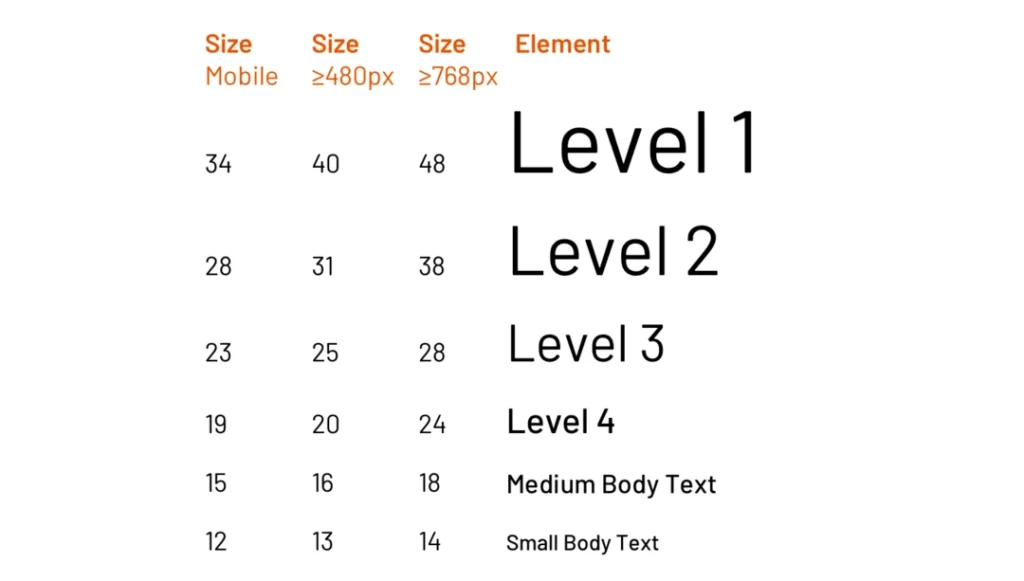
Responsive web design may present some technical challenges, but solutions are available to address them. One challenge is image scaling for different screen resolutions, which can be overcome using techniques such as CSS media queries and flexible image sizing.
By using CSS media queries, it's possible to specify different image sizes and resolutions for different screen sizes. This ensures that images are displayed at the optimal size and resolution for a visually appealing experience on all devices.
Navigation design also must be considered. Techniques such as collapsible menus or off-canvas navigation can ensure that navigation menus and buttons work well on small and large screens.
For example, on small screens, a collapsed navigation menu that can be expanded with a tap or swipe gesture can provide a better user experience than a traditional horizontal menu by enabling users to access the navigation options without too much screen space.
Performance optimisation is vital to ensure fast loading times on different devices. Techniques such as lazy loading images, minifying CSS and JavaScript, and optimising server response time can help improve performance for responsive websites.
Lazy loading images involves only loading the parts of an image when they're about to be displayed onscreen. This reduces the initial load time of a web page, improving overall performance – especially useful if your audience is likely to have slower internet connections.
Cross-browser compatibility is crucial for consistent rendering across browsers. Testing websites in multiple versions of multiple browsers, plus using tools like CSS vendor prefixes and polyfills, helps deliver consistent experiences for everyone.
Not all web browsers support certain features (especially older ones), so adding CSS vendor prefixes or polyfills ensures website styling/layout consistency regardless of browser/version.
Managing CSS media queries used for targeted styling based on screen dimensions can become tricky; however, effective organisation/structuring of your stylesheets (using preprocessor tools like Sass or LESS) plus following modular design principles makes dealing with them more manageable.
For example, Organising your project into separate files based on different device widths would make it easier to manage/update media queries on your site and help maintain a modular/scalable codebase.
The Future of Responsive Web Design
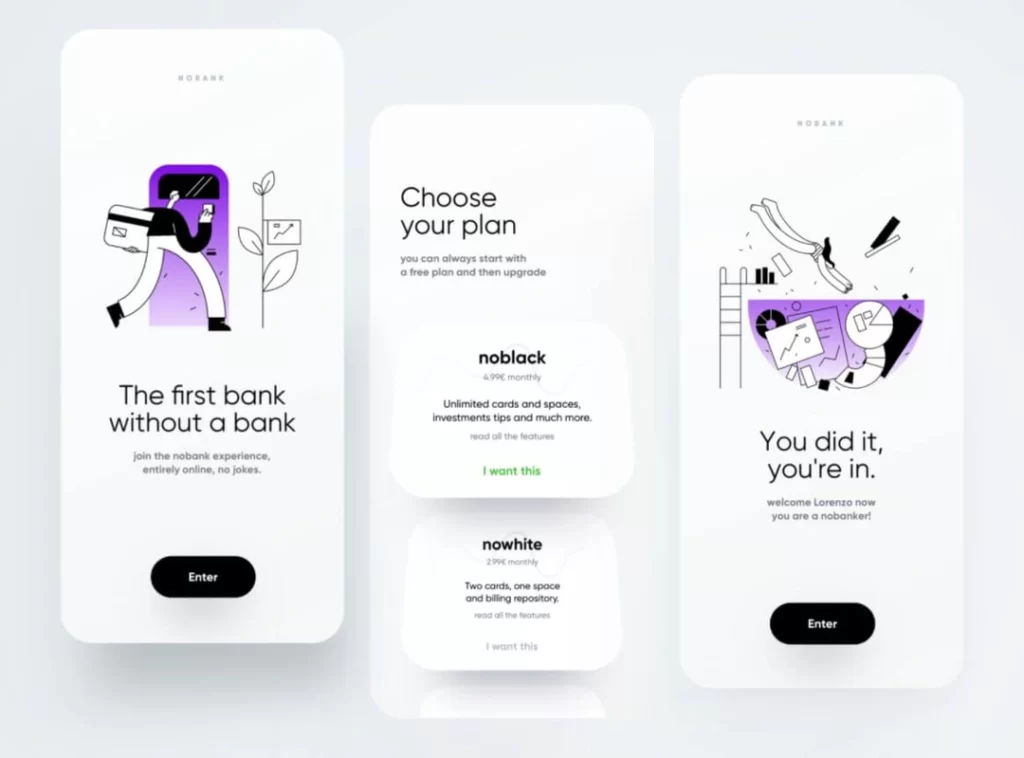
Responsive web design is continuously evolving to meet the demands of new devices, resolutions, and technologies. Designers and developers must adapt to stay on top of this ever-changing landscape to deliver a good user experience (UX).
Responsive design has always been about adapting for different screens – hence its focus on layout grids based on percentages or proportions rather than fixed widths. As Chris Coyier argued: “We don't just ‘design websites' any more. We increasingly ‘design experiences', whether they happen mostly in a browser window or not.”
But as time passes, the range of screens we need to accommodate grows. Most people have several screens – typically a smartphone and tablet plus a laptop or desktop PC – but some also have wearables like smartwatches with tiny screens; others may own internet-enabled TVs with much larger ones.
Accordingly, designers now speak quite naturally about “small-screen” versus “large-screen” designs within responsive layouts; according to Molly Wilson: “We need our content hierarchy change depending on context – if you pull up my site on your phone while waiting at Starbucks it should show you something completely different than if you're sitting in front of your 27in iMac.”
This approach works well enough when phones are relatively small compared with desktop monitors because most websites were initially designed for desktop viewing anyway: their structure can be rearranged fairly easily into single columns for smaller devices.
However, there's no guarantee that future mobile devices won't feature substantial widescreen displays à la Samsung Galaxy S8, nor will desktops always consist of rectangular devices.
Users already have a wider choice of screen sizes and resolutions than ever before – the most minuscule smartphone display currently available measures 2.45 inches (6.22cm) diagonally, and the most extensive monitor is 79 inches. And some TV sets dwarf both; optimising layouts for every possible device is impossible.
Web designers' challenge is creating flexible designs that look good and work well on as many screens as possible without resorting to device-specific layouts or subdomains – something Google has deprecated since 2012 because “it confuses mobile users”.
The situation is further complicated by new technologies such as IoT gadgets which feature tiny display screens: think of all those web-enabled fridges with built-in touchscreen tablets or recipe apps where you can watch videos of celebrity chefs preparing dishes using nothing but an ambient-temperature salad crisper.
It's worth noting that responsive design isn't just about layout grids that change based on breakpoints in media queries; it also encompasses responsive images, typography and performance (e.g. reducing file sizes or increasing font size when a network connection degrades).
Nor should we assume responsive design principles apply only to “traditional” websites viewed primarily through browsers. Responsive designs now crop up everywhere there are digital interfaces, including native apps – e.g. Facebook's Paper app for iOS included multilayer parallax scrolling effects that responded to accelerometer input.
Conclusion
Responsive website design is critical to guarantee the best user experience and functionality across devices. Responsive design adjusts to various screen sizes and gadgets, offering a constant visual experience that improves engagement, makes analytics easier to report on, and enables search engine rankings to improve. Following best practices and critical principles of responsive design, websites can quickly adapt their layout, images, typography and content to any screen. As the digital landscape changes with new gadgets and technologies, it remains an essential approach for creating sites that cater to the ever-changing digital landscape.
